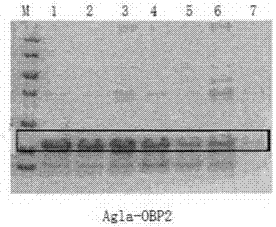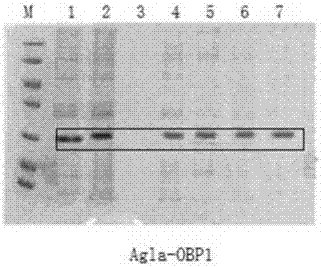Method for screening anoplophora glabripennis attracting components and preparing anoplophora glabripennis attractant
A glaucous longhorn beetle and attractant technology, applied in the field of forestry and forest protection, can solve problems such as the difficulty of screening out the attracting active ingredients, single host plants or herbivorous insects
- Summary
- Abstract
- Description
- Claims
- Application Information
AI Technical Summary
Problems solved by technology
Method used
Image
Examples
specific Embodiment approach 1
[0027] Specific embodiment one: a kind of method of screening Beetleus glabra's attractant composition comprises the following steps:
[0028] Step 1: extracting and purifying the total RNA of the antennal sensilla of Beetleus glabrata;
[0029] Step 2: Obtain the full length of the odor-binding protein of Beetle glabrata;
[0030] Step 3: Construct the prokaryotic expression vector of the odorant binding protein of Beetle glabrata;
[0031] Step 4: Induction and purification of the recombinant odorant-binding protein of Beetle glabrata;
[0032] Step 5: Screening and identification of the attractant components of the bald-shouldered beetle.
specific Embodiment approach 2
[0033] Specific embodiment two: the difference between this embodiment and specific embodiment one is: the specific process of the extraction and purification of the total RNA of the antennal sensilla in the step one is as follows:
[0034] Use Trizol reagent to extract total RNA from the antennae of Beetleus glabrata, use non-enzymatic DNA removal-A (DNA-Be-Gone-A) to remove residual DNA in the total RNA, and use 0.01 agarose gel electrophoresis to detect the integrity of the total RNA; use SMART IVoligonucleotide Reverse transcription with CDSⅢ / 3'PCR primer (primer), and incubate at 42°C for 1 hour to generate the first strand of cDNA.
[0035] Other steps and parameters are the same as those in Embodiment 1.
specific Embodiment approach 3
[0036] Specific embodiment three: the difference between this embodiment and specific embodiment one or two is that: the specific process of obtaining the full length of the odor-binding protein of Beetleus glabrata in said step two is:
[0037] Primer design for Agla-OBP1, Agla-OBP2,
[0038] Agla-OBP1 primer sequence:
[0039] Forward: 5'-ATGAAACTTTTTGTATTCGTCC-3'
[0040] Reverse: 5'-TTAGGGCAAGAAATAATTCGAG-3'
[0041] Agla-OBP2 primer sequence:
[0042] Forward: 5'-ATGTCGCTCAGAATCGTTATCG-3'
[0043] Reverse: 5'-CTATACCAGGAACCAGTTCTCC-3'
[0044] Amplification, cloning and sequencing of the cDNA of odorant-binding proteins Agla-OBP1 and Agla-OBP2 from Beetle glabrata. Use the first strand of cDNA synthesized by reverse transcriptase as a template, and use primers to amplify it by PCR; reaction system: Pfu 0.5 μl, PfuBuffer+Mg 2+ (SO 4 2- ) 5.0 μl, dNTP 4.0 μl, cDNA 1.0 μl, Agla-OBP1-forward 1.0 μl, Agla-OBP1-reverse 1.0 μl, ddH 2 O 37.5μl; PCR amplification program:...
PUM
 Login to View More
Login to View More Abstract
Description
Claims
Application Information
 Login to View More
Login to View More - R&D Engineer
- R&D Manager
- IP Professional
- Industry Leading Data Capabilities
- Powerful AI technology
- Patent DNA Extraction
Browse by: Latest US Patents, China's latest patents, Technical Efficacy Thesaurus, Application Domain, Technology Topic, Popular Technical Reports.
© 2024 PatSnap. All rights reserved.Legal|Privacy policy|Modern Slavery Act Transparency Statement|Sitemap|About US| Contact US: help@patsnap.com










